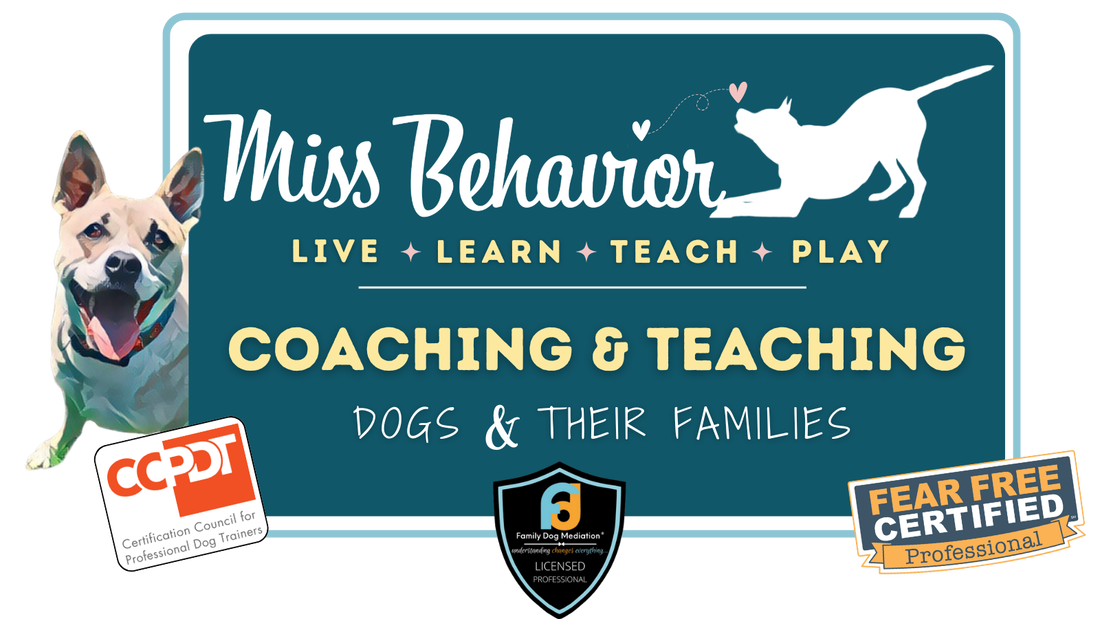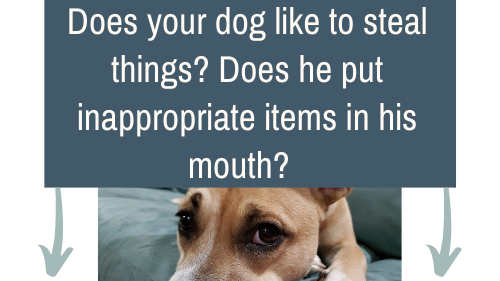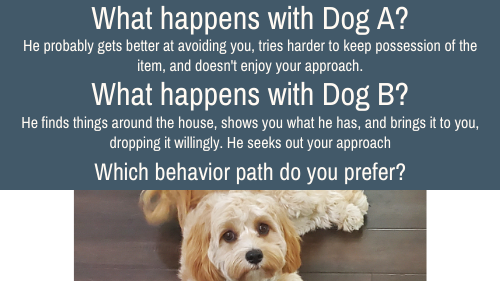Whether you have a puppy, a teenager, or an adult dog playing the game of keep-away with what he found, you have two choices in the momentYou could jump on Path A: Catch your dog, take the item, and put it away or throw it away or... You could jump on Path B: Grab a treat, offer it to your dog in exchange for what he stole, and then take the item Where does Path A take you? Where does Path B take you? They go in two very different directions! So what happens if you stay on Path A? Your dog likely gets better at avoiding you, moves faster, holds on longer, and gets avoidant of your approach because he wants to keep that item. He might even make a fun (for him) game out of it and play keep away until you finally trap him This is a dog who may even get possessive or items or start guarding them (freezing, growling, snapping, or even swallowing the item) What happens if you stay on Path B? Your dog might start grabbing random things when looking for some attention, showing you that he has them so you can exchange it for a treat. But he drops it willingly, he comes toward you, not away from you, and he trains you to pay him for his retrieve of your own items. So dog A or dog B? Dog B trusts you while dog A does not Dog B is performing a learned behavior while Dog A gets emotional Dog B has a fun party trick while Dog A needs heavy management for safety Let's address some commonly asked questions and concernsBut Laura, my dog doesn't want the treat when he steals somethingThen it's time to be intentional about teaching it. You need to take the time to teach the behavior with a less novel item. You need to practice with one of his own toys that he can safely have back. You can increase the value of the treat. You want to increase the value of what you have and decrease the value of what your dog has. A little reverse psychology goes a long way here But Laura, won't my dog start looking for things to steal on path B?Yes, it's likely. However, if you get really good about intentionally teaching this and play the game with appropriate items often enough so your dog isn't getting more reward for novel items than appropriate items, it won't be so bad. And guess what? When you have a learned behavior, you can easily wean off the treats or add cues and replacement behaviors. That is much harder to do with a dog who is in an emotional state of mind. But Laura, my dog is already being possessiveThen you take a LOT of extra safety measures and make it a PRIORITY to teach this intentionally. On top of that, you definitely reach out to me or to another qualified professional, force-free trainer for extra guidance to keep everyone safe
0 Comments
Your comment will be posted after it is approved.
Leave a Reply. |
|
- Home
- About
- Blog
- Services
- Membership
-
Courses & Freebies
- All Courses
- FREE Boredom Buster Recipes
- COURSE: Building Resilience in your Family Dog
- COURSE: Managing the Leash Walk
- Potty Training COURSE
- Paws Off COURSE
- COURSE: Managing the Leash Walk
- FREE Attention Building Challenge
- FREE Scratchboard Training
- FREE Rest and Recovery Round-Up
- FREE Body Language 101
- Contact
- Home
- About
- Blog
- Services
- Membership
-
Courses & Freebies
- All Courses
- FREE Boredom Buster Recipes
- COURSE: Building Resilience in your Family Dog
- COURSE: Managing the Leash Walk
- Potty Training COURSE
- Paws Off COURSE
- COURSE: Managing the Leash Walk
- FREE Attention Building Challenge
- FREE Scratchboard Training
- FREE Rest and Recovery Round-Up
- FREE Body Language 101
- Contact
Search by typing & pressing enter







 RSS Feed
RSS Feed





